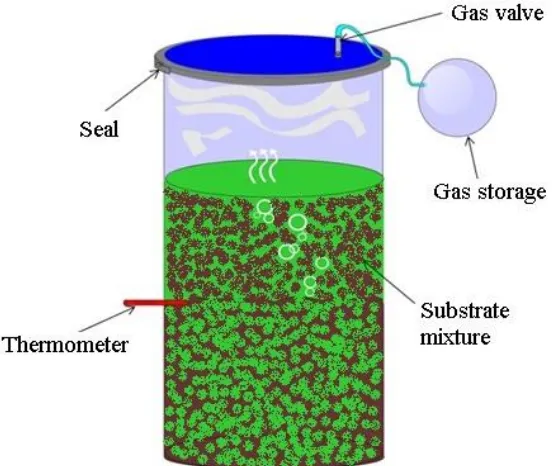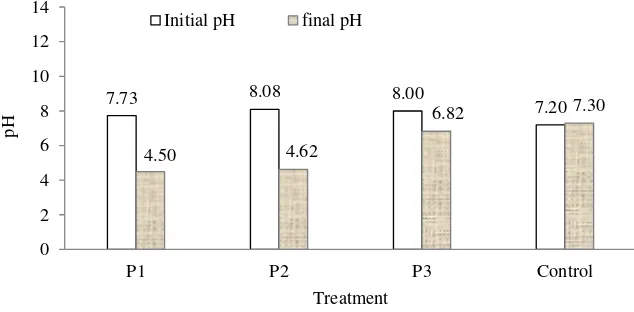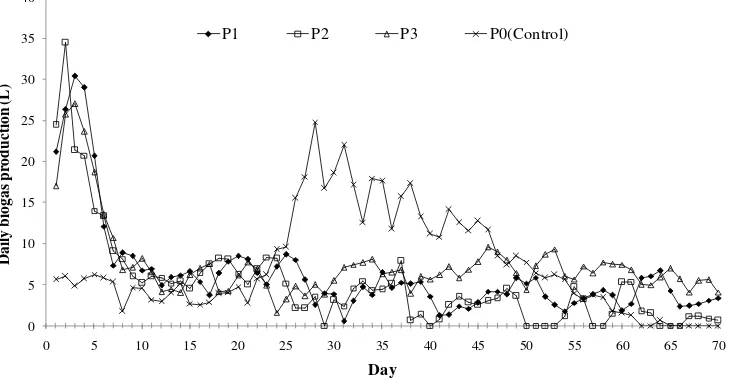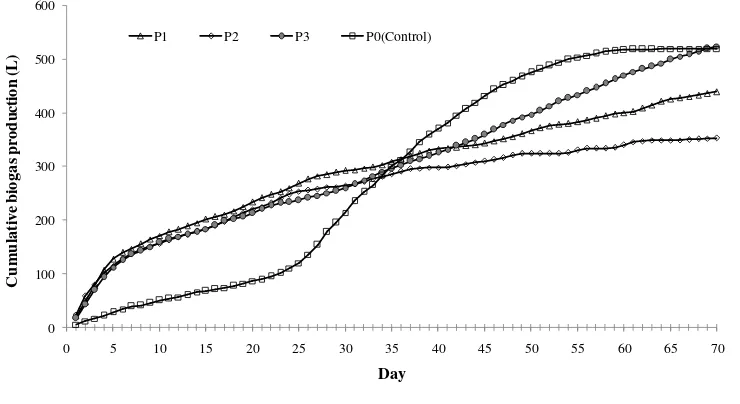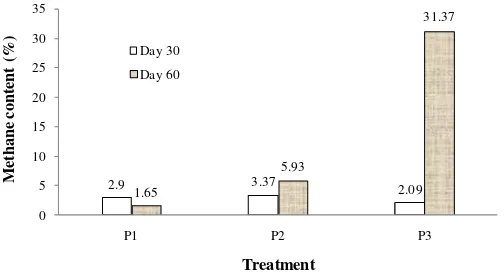IOP Conference Series: Earth and Environmental Science
PAPER • OPEN ACCESS
Biogas production from anaerobic codigestion of cowdung and elephant
grass (Pennisetum Purpureum) using batch digester
To cite this article: Agus Haryanto et al 2018 IOP Conf. Ser.: Earth Environ. Sci.141 012011
1
Content from this work may be used under the terms of theCreative Commons Attribution 3.0 licence. Any further distribution of this work must maintain attribution to the author(s) and the title of the work, journal citation and DOI.
Published under licence by IOP Publishing Ltd
1234567890 ‘’“”
ICBBogor 2017 IOP Publishing
IOP Conf. Series: Earth and Environmental Science 141 (2018) 012011 doi :10.1088/1755-1315/141/1/012011
Biogas production from anaerobic codigestion of cowdung
and elephant grass (
Pennisetum Purpureum
) using batch
digester
Agus Haryanto1,*, Udin Hasanudin2, Chandra Afrian1, Iskandar Zulkarnaen1
1 Agricultural Engineering Department, Faculty of Agriculture, The University of
Lampung. Soemantri Brojonegoro Road #1, Bandar Lampung, Indonesia.
2 Agricultural Product Technology Department, Faculty of Agriculture, The University
of Lampung. Soemantri Brojonegoro Road #1, Bandar Lampung, Indonesia.
* E-mail: [email protected]
Abstract. This study aimed at determining biogas production from codigestion of Elephant grass and cowdung using batch digester. Fresh grass was manually chopped with a maximum length of 3 cm. Chopped grass (25 kg) was perfectly mixed with fresh cowdung (25 kg). The mixture was introduced into a 220-liter batch drum digester. The substrate was diluted with water at different rates (P1 = 50 L, P2 = 75 L, and P3 = 100 L) and was stirred thoroughly. Six digesters were prepared as duplicate for each treatment. Two other digesters containing only 25 kg cowdung diluted with 25 L water were also provided as control treatment (P0). The digesters were air tightly sealed for 70 days. Observation was conducted on daily temperature, substrate pH (initial and final), TS and VS content, biogas yield and biogas composition. Results showed that final pH of grass containing substrate was in the acidic range, namely 4.50, 4.62, 6.82, whereas that of control (P0) was normal with pH of 7.30. Digester with substrate composition 25:25:100 (cowdung:grass:water) produced the highest biogas total (524.3 L). Biogas yield of codigestion, however, was much lower as compared to that of control, namely 7.35, 16.75, and 111.72 L/kg VSr respectively for treatment P1, P2, P3. with dilution rate of 50, 75, and 100 L. Biogas produced from control digester had methane content of 53.88%. In contrast, biogas resulted from all treatments contained low methane (the highest was 31.37%). Methane yield of 39.3 L/kg TS removal was achieved from digester with dilution 100 L (P3). Mechanical pretreatment is suggested to break Elephant grass down into smaller particles prior to introducing it into the digestion process.
1.Introduction
Biogas is mixture of flammable gas produced through anaerobic digestion process of organic materials. During this process, complex organic matter such as protein, fats, and carbohydrate polymers (cellulose and starch) are first hydrolysed into monomer like amino acids, long-chain fatty acids, and sugars. These monomers are then fermented to form volatile fatty acids (lactic, propionic, and butyric acids) during acidogenesis (second step). In the third step (acetogenesis), bacteria consume these volatile fatty acids and generate acetic acid, carbon dioxide (CO2), and hydrogen (H2). Finally,
1234567890 ‘’“”
ICBBogor 2017 IOP Publishing
IOP Conf. Series: Earth and Environmental Science 141 (2018) 012011 doi :10.1088/1755-1315/141/1/012011
The biogas is mainly composed of CH4 (45-70%) and CO2 (30-45%) and traces of H2, water vapour
(H2O), ammonia (NH3), and hydrogen sulphide (H2S) [1, 2]. Biogas can be used to fuel several
applications, from cooking stove to generating electricity. Biogas technology is now an ecologically sound option to reduce environmental burden by decomposing organic material and producing not only energy but also good quality organic fertilizer [3, 4].
Grasses are efficient at cellulosic biomass production. Grasses give more benefit because of sequestering more carbon, requiring less tillage and consuming less fertilizers and pesticides [5], consuming less water and can be cultivated on non-arable soil [6]. In recent years, perennial grasses have been identified as leading candidates for bioenergy production including switchgrass (Panicum virgatum L.) in North America [7], giant miscanthus (Miscanthus giganteus) in Europe [8], and Elephant grass or Napier grass (Pennisetum purpureum Schumach) in Thailand [9–11].
Elephant grass, originating from Africa, has been successfully cultivated in Indonesia for cattle feed purposes. The plant has a high posture, wide (3 cm) and length (30-90 cm) leaves, and it is one of the highest-yielding tropical forage grasses [12]. Munasik et al. [13] reported that this grass can achieve a height of 259.6–289.2 cm and yield of 70–100 ton fresh biomass or 1.11–1.57 ton dry matter per hectare at 60 days old after planting. Biomass yield is influenced by age, the older the higher [11]. Field observation at PT. Great Giant Livestock, Central Lampung showed that the grass is able to be ratooned 6–7 times before replanting [14]. In addition to high yield, Elephant grass grows fast and is highly adaptive, and is easy in propagation and management [11]. The grass is also tolerant in acidic soil [13], copper [15], and drought condition [12].
Studies on biogas production by co-digestion of animal wastes with grass have attracted special interest. The grass has such high in organic substrate that it is good potential as co-substrate for biogas production. [11] Jewell et al. [16] examined the production of biogas from energy crops including Elephant grass with TS of 25-30% and obtained maximal methane production levels. Ekpenyong et al. [17] reported biogas production from anaerobic fermentation of ground dry elephant grass stems about 450 ml for 5 days with 4 g of substrate. An increase in biogas production by 40% was obtained by the addition of 0.01 g Urea. Ahn et al. [18] examined the anaerobic fermentation performance of dry grasses of switchgrass mixed with different livestock manure (pigs, poultry and dairy cattle) at 15% TS
and thermophilic temperature (55°C). Mixture with pig manure resulted in a decomposition of VS
(volatile solids) of 52.9%, higher than poultry manure mixture (9.3%) and dung cow dung (20.2%). For 62 days of residence time, the mixture of grass with pig manure produced the highest methane (0.337 L/g VS), whereas the mixture with dairy cow manure and poultry droppings respectively yielded 0.028 and 0.002 L CH4/g VS.
Recently, Sinbuathong et al. [11] stated that cutting age affected methane yield with grass cut at 30 days after planting produced the highest, achieving 197 (L/kgTVS added). Total methane yield per hectare (6500 m3/ha), however, was achieved at cutting age of 60 days. Sawanon et al. also reported
that amount of the composition of substrate also influenced the biogas yield with the highest rate of 169 L/kg TVS added was achieved at a composition of 10:10:20 (grass:cowdung:water) [10]. Olugbemide et al. [19] noted that co-digestion of maize leaves and Elephant grass at a ratio of 60%:40% produced 67.3% higher biogas as compared to digestion of maize leaves alone. Evaluation of large scale biogas production using anaerobic co-digestion of pig manure and elephant grass silage for car transportation has been conducted in Thailand with a conclusion that co-digestion of pig manure and grass silage is a promising approach for improving biogas production [9].
Utilization of Elephant grass for biogas substrate will actually compete with animal feed, especially for grass fed cattle and buffalo. With high productivity and digestibility, however, this grass can be dedicated solely for energy crop in remote areas. Tufvessonet al. (2013) concluded that if there is no demand for them as animal feed, all residues studied are well suited for biogas production. Otherwise, growing dedicated biogas crops directly will be more efficient [20].
3
1234567890 ‘’“”
ICBBogor 2017 IOP Publishing
IOP Conf. Series: Earth and Environmental Science 141 (2018) 012011 doi :10.1088/1755-1315/141/1/012011
2.Materials and Methods
2.1.Digester preparation
Digester was prepared using plastic drum with a volume of 220 L as presented in Figure 1. The lid was wrapped with rubber band as a seal to make the digester airtight. A hole on the lid of the drum was provided to deliver biogas into a storage balloon trough a plastic tube. The tube was facilitated with a stop valve to close the piping for biogas volume measurement and biogas sampling. Another hole was also made on the drum to insert a thermometer through a rubber cock.
Fig. 1 A 220-L drum digester prepared for the experiment
2.2.Substrate preparation
Fresh cowdung was taken from the Department of Animal Husbandry, the University of Lampung. Elephant grass was cut at around 2 months of age from a farmer field in Pesawaran District, Lampung. Before starting the anaerobic digestion experiments, samples of grass and cowdung were analysed for total solids (TS), volatile solids (VS), and carbon (C) and nitrogen (N) contents. Table 1 shows characteristic of separate substrate.
Table 1. Freshsubstratecharacteristic
Characteristic Cowdung Elephant grass
Water content (%, wet basis) 71,32 87,03
Total solid (TS) (%, wet basis) 28,68 12,97
Ash (% TS) 25,04 14,41
Volatile solid (VS) (% TS) 74,96 85,59
C (%) 39,87 55,51
N (%) 1,42 1,81
C/N Ratio 28,08 30,62
2.3.Treatments
1234567890 ‘’“”
ICBBogor 2017 IOP Publishing
IOP Conf. Series: Earth and Environmental Science 141 (2018) 012011 doi :10.1088/1755-1315/141/1/012011
was manually stirred in order to homogenize the substrate. The lid of the drum was then closed with a rubber seal. Two drum digesters were provided for each treatment as duplicate. Two other digesters were also prepared for control treatment containing only cowdung and water with mass ratio of 1:1 and thoroughly mixed. Table 2 shows substrate composition of all treatments.
Table 2. Treatment and substrate composition
Treatment Cowdung
For determining the total solids (TS), samples with certain weight were placed in ceramic vessels and dried in a drying oven (Memmert, type UM 500, Germany) at 105 °C for 24 hours until constant weight. After cooling in the desiccators, the samples were weighed for TS measurement. The samples was then burnt in a furnace (Barnstead Thermolyne FB1300, USA) at 550 °C for 2 hours for volatile solids (VS) determination. The VS is determined by subtraction of the minerals content of the sample (residual ash after oxidation) from the total solids content. Total solid, VS, and removed VSr are
calculated by using Eq. (1) to (3), respectively:
TS (%, wb) = 100
Carbon and nitrogen contents of each substrate were measured using element analyzer (Elementar Vario EL Cube, Germany). Carbon to nitrogen ratio (C:N) of the mixture is calculated using Eq. (4):
)
where m is dry mass and subscripts c and g denote cowdung and Elephant grass, respectively.
In order to evaluate process condition, temperature and pH of the substrate during experiment were also checked. Daily temperature was monitored from a thermometer inserted in the digester. The pH values were determined using pH meter (PHMETER, PH_009(I), China) for both fresh and spent substrates.
Biogas production was determined daily using simple water displacement method. Biogas composition was measured using gas chromatograph (Shimadzu GC 2014, Japan) with thermal conductivity detector (TCD) and 4-m length of shin-carbon column. Helium gas was used as carrier gas with flow rate 40 ml/min. Biogas yield (BY) was calculated from biogas productivity (BP) and VSr
5
1234567890 ‘’“”
ICBBogor 2017 IOP Publishing
IOP Conf. Series: Earth and Environmental Science 141 (2018) 012011 doi :10.1088/1755-1315/141/1/012011
and pH are among the important factors. Figure 2 shows daily temperature of the digesters. All digesters operated in the mesophilic temperature region with a range of 30.7 – 35.5 oC for P1, 28.6 –
30.5 oC for P2, 28.6 – 29.8 oC for P3, and 28.8 – 31.2 oC for P0 (control). These digesters worked at
temperature higher than ambient temperature (26.4 – 28.6 oC) mainly due to exposure to sun rays.
Different shading conditions also caused temperature differences among the treatments. Even though all digesters placed under the same roof overhang of a building, there were different shading conditions due to the existence of surrounding trees and buildings. This is confirmed by digester temperature in each treatment, which differs from morning to noon to afternoon. Digester temperatures at noon and afternoon are higher than that at morning. Digesters for treatment P1 show the highest temperature than the other treatments. This is caused by digesters position that are more exposed to sun radiation than the others especially during day and afternoon.
26.4
Fig. 2 Average working temperature of batch drum digesters
7.73 8.08 8.00
Fig. 3 Acidity of fresh and final substrate for different treatments
1234567890 ‘’“”
ICBBogor 2017 IOP Publishing
IOP Conf. Series: Earth and Environmental Science 141 (2018) 012011 doi :10.1088/1755-1315/141/1/012011
degradation processes meet the requirement for both activities and cell growth of anaerobic microorganisms at pH of 5.5–8.5.
During the experiment lasted for 70 days, however, the pH decreases to acidic condition, especially for digesters with dilution rate of 50 L and 75 L. This indicates that dilution rate influences acidity of the substrate. More dilution resulted in better pH value in term of anaerobic process. At the end process, acidity value of digester P1 and P2 revealed acidic condition. Digester P3 showed final pH of 6.82 that closes to normal and meet the condition for anaerobic decomposition process. This asserted that dilution rate influences anaerobic decomposition process, the higher the better.
During anaerobic digestion process, substrate decomposition occurs. Table 3 presents characteristic of spent substrates for each treatment. Control digester has the highest decomposition of organic matter, achieving 50% (represented by VSr). This value closes to the performance of family size
digesters having average organic material removal of 51.32% [22]. The addition of fresh chopped Elephant grass resulted in the decrease in decomposition rate. The table showed that organic material degradation of substrate containing grass was in the range of 27.40% to 37.13%. Increase in dilution rate has improved organic material decomposition.
Table 3.Total solid (TS) and volatile solid (VS) of spent substrates
Treatment TS
Figure 4 presents daily biogas production resulted from different treatments. During first week the digesters show decreasing trend of biogas production. Initially, gas is produced from respiration of the substrates due to the existence of air filling void space in the digester. The figure reveals that digesters with grass co-substrate have more extensive respiration process. Oxygen in the air has resulted oxidation reaction that produce CO2 and H2O. The produced gas is exerted out from the digester. The
amount of oxygen in the digester continuously decreases and finally vanishes at which time the anaerobic process starts. The figure implies that anaerobic process starts at the beginning of week two.
0
7
1234567890 ‘’“”
ICBBogor 2017 IOP Publishing
IOP Conf. Series: Earth and Environmental Science 141 (2018) 012011 doi :10.1088/1755-1315/141/1/012011
Figure 4 also reveals that during anaerobic process, digesters containing grass show fluctuated biogas production at an average of 4.67 L/d for P1, 3.47 L/d for P1, and 6.16 L/d for P3. During week three, control digester (P0) demonstrates a significant increase of biogas production. From the beginning of week four, however, biogas production of P0 decreases until practically zero at day 60. On the other hand, digesters containing grass still produce biogas at significant amount, especially digester P1 and P3.
Figure 5 presents cumulative biogas production. During the first month, control digester shows the lowest cumulative biogas yield. This may relate to low respiration during first week due to the absence of fresh grass in the substrate. Starting week fifth, biogas production from control digester lead but stuck at a total of 519 L after day 61. On the other hand, biogas productions with grass co-digestion accumulatively increase for longer time. Digester P3 shows higher cumulative biogas yield than those of P1 and P2. Even by day 68, cumulative biogas yield of P3 (535 L) has surpassed that of P0. This indicates that addition of Elephant grass as a co-substrate is promising to improve total biogas yield. Digester P3 with dilution rate 100 L (twice of the substrate mixture) also produces higher total biogas than those of P1 (439 L) and P2 (353 L) with dilution rate 50 L and 75 L, respectively.
0
Figure 5. Cumulative biogas production from different treatment.
7.35 16.75
Figure 6. Biogas yield codigestion of cowdung and Elephant grass.
Figure 6 shows biogas yield on the basis of removed VS. Digester P0 demonstrates the highest biogas yield (422.58 L/kg VSr). Biogas yield from grass containing digesters is substantially lower
1234567890 ‘’“”
ICBBogor 2017 IOP Publishing
IOP Conf. Series: Earth and Environmental Science 141 (2018) 012011 doi :10.1088/1755-1315/141/1/012011
3.3.Methane yield
The methane content of control digester (53.9%) is much higher as compared to those of grass containing digesters. Biogas produced from digesters containing grass has very low methane content. Methane content is measured twice, at day 30 and day 60. As depicted by Figure 7, at day 30, all digesters with grass have methane content lower than 4%. At day 60, a significant increase in methane content is presented by digester P3 with 33%. No significant changes of methane content occur at digesters P1 and P3 at day 60. This implies that acidification steps still dominate the decomposition process of organic materials. Methanogenesis step has not optimally gone on. This suggests that the presence of fresh grass has slowed down the methane formation and it requires longer time to favour decomposition.
Figure 7. Methane content in the biogas produced from codigestion of cowdung and Elephant grass.
Total solid content of grass containing digesters can be a factor that causes low methane content. Figure 8 shows that in general increasing TS content has resulted in the reduction of methane yield. Even though the graph contains limited data, it provides finding complying with other studies. Liotta
et al. (2014), for example, reported that anaerobic digestion of food waste produces the highest methane yield at TS content of 4.52% and a reduction of the specific methane yield of 4.3% and 40.8% occurs at TS content of 12.87% and 19.20%, respectively [23]. In our experiment, the highest methane yield of 39.3 L/kg TS removal is achieved at TS content of 6.94% or 69.4 g/L. Sawannon et al. [10] reported high biogas yield of 116 LCH4/kg TSr was achieved from co-digestion of cowdung and
Elephant grass at TS content of 22.72 g/L and 142 LCH4/kg TSr at TS content 33.08 g/L. This means
that there is a room to increase methane yield by decreasing TS content or increasing dilution rate.
y = -6.654x + 71.28
9
1234567890 ‘’“”
ICBBogor 2017 IOP Publishing
IOP Conf. Series: Earth and Environmental Science 141 (2018) 012011 doi :10.1088/1755-1315/141/1/012011
The size of chopped grass can be an important key to be taken into consideration. The accessibility of microorganisms to the fermentable sugars is restricted because of complex structure of lignocellulosic materials [24]. Reduction of particle size favours the contact between the enzymes with the substrate and reveals new zones which initially inaccessible [6]. In this case, mechanical pretreatments breakdown particle size of complex cellulose and increase the substrate specific surface area available to the microorganisms, and therefore improve the biogas yield [24]. It was reported that the rate of biogas production is highly correlated to particle size and the highest biogas production from agricultural residues was obtained from raw materials of the smallest particles [25-27]. Low biogas yield in our experiment could be resulted from particle size of grass that was barely chopped into a maximum length of 3 cm, longer than those reported sizes.
4.
ConclusionsThe addition of Elephant grass as co-substrate potentially improve total biogas yield. Dilution rate greatly influences biogas yield and its methane content. Digester with substrate composition 25:25:100 (cowdung:grass:water) produced the highest biogas (524.3 L) with methane content (31.37%). Methane content of biogas from co-digestion elephant grass and cowdung, however, substantially lower than that of only diluted cowdung which achieve 53.9%. Biogas yield of codigestion was 7.35, 16.75, and 111.72 L/kg VSr respectively for treatment with dilution rate of 50, 75, and 100 L. Biogas
yield from control digester 422.58 L/kg VSr, much higher than those of grass containing digesters.
Methane yield of codigestion process decreases with TS content. Mechanical pretreatment is suggested to break Elephant grass down into smaller particles prior to introducing it into the digestion process.
Acknowledgement
This work was financially supported by DGHE (Directorate General of Higher Education), Ministry of National Education though Strategis Nasional (STRANAS) research scheme. Contract number: 419/UN26/8/LPPM/2016 (June 6, 2016).
References
[1] Abbasi T, Tauseef S M and Abbasi S A 2012 Biogas Energy (New York: Springer) pp 1–10. [2] Gomez C D C 2013 Biogas as an energy option: an overview. The Biogas Handbook: Science,
Production and Applications, eds A Wellinger, J Murphy and D Baxter. (Cambridge: Woodhead Publishing Limited) pp 1–16.
[3] Higgins K T 2008 Anaerobic gas and cash Food Engineering80(4) 119–20.
[4] Petis M 2006 Anaerobic digestion plant yields nutrients and power BioCycle47(12) 61–2. [5] Moore K J, Fales S L and Heaton E A 2008 Biorenewable energy: new opportunities for
grassland agriculture Multifunctional Grasslands in a Changing World
Proc. XXI
Int. Grassland Conf. vol. II eds X Haining and H Jiehua (Guangzhou: Guangdong People’s Publication House) pp 1023–30.[6] Rodriguez C, Alaswad A, Benyounis K Y and Olabi A G 2017 Pretreatment techniques used in biogas production from grass Renew Sustain Energy Rev68(2) 1193-204.
[7] McLaughlin S B and Kszos L A 2005 Development of switchgrass (Panicum virgatum) as a bioenergy feedstock in the United States Biomass Bioenergy28 515–35.
[8] Lewandowski I, Clifton-Brown J C, Scurlock J M O and Huisman W 2000 Miscanthus: European experience with a novel energy crop Biomass Bioenergy19 209–27.
[9] Dussadee N, Reansuwan K and Ramaraj R 2014 Potential development of compressed bio-methane gas production from pig farms and elephant grass silage for transportation in Thailand Bioresour Technol.155 438-41.
[10] Sawanon S, Sangsri P, Leungprasert S and Sinbuathong N 2017 Methane production from Napier grass by co-digestion with cow dung Energy Solutions to Combat Global Warming.
1234567890 ‘’“”
ICBBogor 2017 IOP Publishing
IOP Conf. Series: Earth and Environmental Science 141 (2018) 012011 doi :10.1088/1755-1315/141/1/012011
[11] Sinbuathong N, Sangsil Y and Sawanon S 2016 Biogas production from Napier prass at parious cutting intervals Energy, Transportation and Global Warming, Green Energy and Technology ed P Grammelis (Switzerland: Springer International Publishing) chapter 29 pp 375–85.
[12] El-Bassam N 2010 Handbook of Bioenergy Crops: A Complete Reference to Species, Development and Applications (London: Earthscan) pp 378–9.
[13] Munasik, Sutrisno C I, Anwar S and Prayitno C H 2012 The growth, yield and quality of elephant grass (Pennisetum purpureum) specific tolerant of acid soils by mutagenesis with ethyl methane sulfonate Animal Production14(2) 87–91.
[14] GGL (Great Giant Livestock) 2014 Personal communication (January 8, 2014).
[15] Liu X, Shen Y, Lou L, Ding C and Cai Q 2009 Copper tolerance of the biomass crops Elephant grass (Pennisetum purpureum Schumach), Vetiver grass (Vetiveria zizanioides) and the upland reed (Phragmites australis) in soil culture Biotechnol Adv. 27 633–40.
[16] Jewell W J, Cummings R O and Richards B K 1993 Methane fermentation of energy crops: maximum conversion kinetics and in situ biogas purification Biomass Bioenergy 5(3-4) 261– 78.
[17] Ekpenyong K I, Arawo J D E, Melaiye A, Ekwenchi M M and Abdullahi H A 1995 Biogas production potential of unextracted, nutrient-rich Elephant-grass lignocelluloses Fuel 74(7) 1080–82.
[18] Ahn H K, Smith M C, Kondrad S L and White J W 2010 Evaluation of biogas production potential by dry anaerobic digestion of switchgrass–animal manure mixtures Appl. Biochem. Biotechnol.160: 965–75.
[19] Olugbemide A D, Imasuen A O, Oleghe P O and Efosa J O 2012 Anaerobic co-digestion of fresh maize leaves with Elephant grass J Appl Sci Environ Manage. 16(1) 133–35.
[20] Tufvesson L M, Lantz M, and Börjesson P 2013 Environmental performance of biogas produced from industrial residues including competition with animal feed – life-cycle calculations according to different methodologies and standards J Clean Prod. 53 214–23. [21] Stafford M G 1982 The Effect of pH on Methane Production from Dairy Cattle Manure,
Masters Thesis (USA: University of Central Florida).
[22] Haryanto A, Cahyani D, Triyono S, Murdapa F and Haryono D 2017 Economic benefit and greenhouse gas emission reduction potential of a family-scale cowdung anaerobic biogas digester Int. Journal of Renewable Energy Development 6(1) 29–36.
[23] Liotta F, d’Antonio G, Esposito G, Fabbricino M, van Hullebusch E D, Lens P N L, Pirozzi F, and Pontoni L 2014 Effect of total solids content on methane and volatile fatty acid production in anaerobic digestion of food waste Waste Manag Res. 32(10) 947-53.
[24] Rodriguez C, Alaswad A, El-Hassan Z and Olabi A G 2017 Mechanical pretreatment of waste paper for biogas production. Waste Manag. 68 157–64.
[25] Sharma S K, Mishra I M, Sharma M P, and Saini J S 1988 Effect of particle size on biogas generation from biomass residues Biomass 17 251–63.
[26] Hills D J and Nakano K 1984 Effects of particle size on anaerobic digestion of tomato solid wastes. Agric Wastes 10 285–95.
